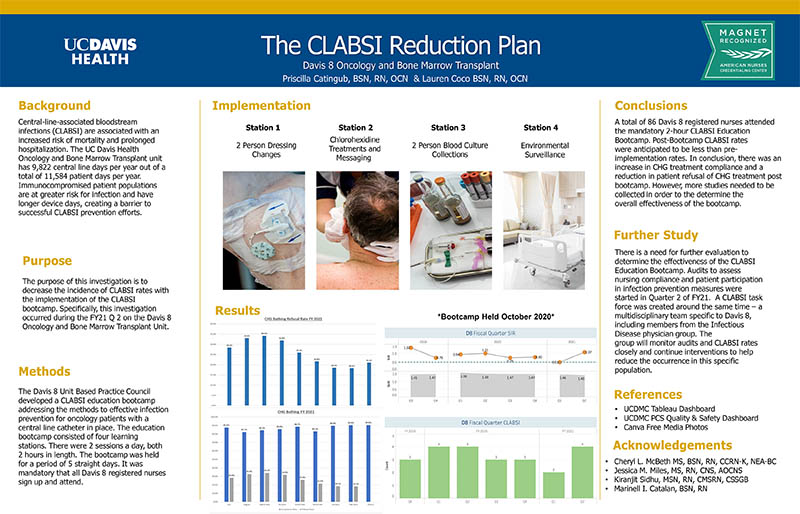
Hover to pan and click to magnify. Click again to pan at full screen.
Priscilla Catingub, BSN, RN, OCN and Lauren Coco, BSN, RN, OCN
Priscilla Catingub, BSN, RN, OCN and Lauren Coco, BSN, RN, OCN
UC Davis Health, Davis 8 Oncology/ Bone Marrow Transplant Unit
ABSTRACT
Title: The Central Line Associated Bloodstream Infection Reduction Plan
Authors: Priscilla Catingub, BSN, RN; Lauren Coco, BSN, RN, OCN
Background: Central line-associated bloodstream infections (CLABSI) are associated with an increased risk of mortality and prolonged hospitalization. The UC Davis Health Oncology and Bone Marrow Transplant unit has 9,822 central line days per year out of a total of 11,584 patient days per year. A literature review was also performed on CINAHL, PubMed, and EBSCOhost using the terms “CLABSI”, “Oncology”, “Immunocompromised”, “Infection Prevention”, and “HAI transmission” and “Central Line Care”. Immunocompromised patient populations are at greater risk for infection and have longer device days, creating a barrier to successful CLABSI prevention efforts.
Purpose: The purpose of this investigation is to decrease the incidence of CLABSI rates with the implementation of the CLABSI bootcamp. Specifically, this investigation occurred during the FY21 Q2 on the Davis 8 Oncology and Bone Marrow Transplant Unit.
Design/Method: The University of California Davis Medical Center is a 625 academic medical center that houses 35 acute care beds on the Hematology/Oncology and Bone Marrow Transplant unit for patients with malignancy. The Unit Based Practice Council for this unit implemented a CLABSI Bootcamp in October 2020 which focused on proper central line maintenance. Four learning stations were created. One station included a 2 person central line dressing change, another focused on a 2 person blood culture collection. The last two stations educated staff on chg treatment and proper messaging to patients as well as the importance of decluttering patient’s rooms. Attendance was required for 100% of the nursing care staff. The Bootcamp was held for the length of five days. There were 2 sessions a day, both 2 hours long.
Implementation: In addition to current infection prevention bundles, a 2-person central line dressing change and a 2 person blood culture collection was made a mandatory practice on the unit and a cart containing central line care supplies was created. CHG treatment and decluttering patient’s rooms was discussed and the staff was educated on different ways they could message how important it is that the patients do their daily CHG treatment.
Results/Findings: A total of 86 registered nurses attended the mandatory 2-hour CLABSI Education Bootcamp. Post-bootcamp CLABSI rates were anticipated to be less than pre- implementation rates. In conclusion, there was an increase in CHG treatment compliance and a reduction in patient refusal of CHG treatment. However, there is a need for further evaluation to determine the overall effectiveness of the CLABSI Education Bootcamp.
Conclusion: Audits to assess nursing compliance and patient participation in infection prevention measures were started in Q3 FY21. A CLABSI task force was created around the same time- a multidisciplinary team specific to Davis 8, including members from the Infectious Disease physician group. The group will monitor audits and CLABSI rates closely and continue interventions to help reduce the occurrence in this specific population.

DISQUS COMMENTS WILL BE SHOWN ONLY WHEN YOUR SITE IS ONLINE